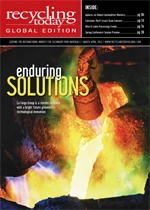 “Unprecedented consumption growth as far as the eye can see,” said Tom Akers, president of Metals Exchange Corp., St. Louis, U.S.
“Unprecedented consumption growth as far as the eye can see,” said Tom Akers, president of Metals Exchange Corp., St. Louis, U.S.
While this was among the most bullish statements made during the Platts Aluminum Symposium, held in Fort Lauderdale, Florida, 15-17 Jan., others expressed similar optimism about aluminium markets for the next three to five years.
Acknowledging a number of short-term challenges, most presenters said they saw the improving U.S. economy, rapidly accelerating economies in developing countries (especially China), and improvement in the transportation sector as key indicators of better markets for aluminium.
First, however, the industry has to get past the murky short-term conditions that have created temporary overcapacity in the market, leading to production cuts. A key drag on the aluminium market is the concern about European sovereign debt.
Reflecting the bearish short-term outlook, U.S.-based Alcoa has announced plans to cut its global production by 12% in response to sharply lower prices. The cuts are being made at facilities in the U.S. and Europe. Alcoa said aluminium prices have dropped by more than 25% from earlier in 2011.
Falling Prices
The price drop was another key concern cited by some speakers, though many of them shrugged off the long-term implications. Jorge Vasquez, managing director of the Aluminum Intelligence Unit for Harbor Commodity Research, a U.S.-based consulting firm to the aluminium industry, estimated that roughly 29% of global aluminium capacity was underwater at today’s price, with about 70% of the unprofitable capacity in China and Europe.
Regarding how significant the overcapacity was, Vasquez said even though significant production cuts have been announced, a large amount of additional capacity remained to be eliminated. “Smaller cuts could be coming,” he added.
Agreeing with what many other industry observers have been saying, Vasquez said in looking at price volatility over the past year, it was apparent that investment funds have been a key factor in driving prices. As disconcerting as the price drop was during the third quarter of 2011, prices still were up for the year. “Funds shorted the aluminium markets,” Vasquez said.
Despite the sharp drop in prices seen during the second half of 2011, Vasquez said the level of fear has declined in the United States and Asia. This translates into improved consumer confidence, which bodes well for a more sustainable recovery, he added.
|
A Mixed Bag for End Markets North American end markets for aluminium fall into several camps. The auto and transportation industry are expected to be strong drivers for aluminium going forward, while the building and construction industry may see further challenges. At the 2012 Platts Aluminum Symposium, Tom Schaebel, CEO of Alexandria Extrusion Co., Alexandria, Minn., and past chairman of the Aluminum Extruders Council (AEC), touched on end-market developments from his position with the AEC. He noted that a significant portion of the extrusion industry—most notably windows and doors—has encountered challenges in light of the slide in new housing starts. Highlighting the difficult extrusion market, Schaebel noted that in 2006, more than 4 billion pounds of extruded aluminium were produced; in 2011, that figure dropped to 2.5 billion pounds. Along with the slump in the U.S. housing sector, the import of extruded aluminium products from China started to grow from roughly 4.7% of the U.S. market from 2000 to 2006, to more than 19% from 2007 to 2010. While the construction industry will be a challenge, the auto industry holds much greater promise. Brad Soultz, executive committee member of the Aluminum Association’s Aluminum Transportation Group, said that better fuel economy, improved safety and enhanced performance are helping to increase the use of aluminium in automobiles. Soultz said a survey of the North American auto industry, performed by research group Ducker Worldwide, revealed that aluminium use in automobiles has shown an average increase of 7 pounds per year for the past 35 years. The survey forecasts an average of 343 pounds of aluminium per vehicle in 2012. The figure is expected to increase to 400 pounds per vehicle by 2015/2016 and to 550 pounds by 2025. |
“In a certain way fear drives demand for aluminium and prices,” Vasquez said. “And, while fear levels have declined in the United States and Asia, they have climbed in Europe. This is reflective of the continued concerns with the European economy.”
He added, “In spite of the spike in fear and the heavy destocking that took place during the end of last year, the primary aluminium market experienced a small deficit, which was driven by China. With no expansion slated for the North American aluminium industry over the next four years, there could be a growing aluminium deficit seen in North America, with market deficits widening over the next year.”
Akers, who voiced the most bullish outlook, added that total aluminium consumption could double during the next 15 years, with most of the growth coming from developing countries. “Per capita consumption growth in the developing world will trump everything in the long run,” Akers predicted.
Gregory Wittbecker, vice president of marketing for U.S.-based Alcoa Materials Management, said despite the seemingly bleak macro-economic news, aluminium markets were fairly strong last year. At the close of 2011, China, which was in a structural deficit of aluminium, balanced a surplus produced by the rest of the world.
Issues such as the sovereign debt in Europe, the earthquake in Japan, inflation in emerging markets, energy and infrastructure shortages in India and weak energy export revenues in Russia have cast a pall on the aluminium industry, though there are enough positives to buoy the outlook during the next three years.
As for 2012, Wittbecker forecasted a moderately slower pace, with growth at less than 10%. The big drag, he added, would be Europe.
Wittbecker also concurred with Vasquez’ outlook that a sizable number of aluminium smelters in China are “operating underwater at the end of 2011.”
Gordon Hamilton, vice president of metal management, Rio Tinto Alcan, Montreal, saw some of the positives, saying, “2011 was not a bad year at all.” He added, “GDP (gross domestic product) is expected to grow 2% in 2012, versus 1.8% in 2011.”
Unlocking the Key
Despite European challenges, economies in the U.S. and China and other emerging countries have rebounded, helping propel aluminium markets. “The long-term fundamentals remain positive,” Hamilton said. The key drivers, he added, will be the rapid urbanisation and industrialisation of emerging economies, which will require a tremendous amount of aluminium to meet structural needs.
“China is the key to the aluminium industry,” Hamilton continued. “The country accounts for around 42% of the global aluminium demand, and that number could rise to 52%.”
Patricia Mohr, vice president of economics for Scotia Capital, based in Toronto, noted that in addition to demand growth, there are no expansions scheduled in North America, which should help to keep supply and demand in balance.
As for China, Mohr said social housing built by the government would continue to grow, which would strengthen aluminium markets. In her presentation, Mohr said China had posted double-digit growth rates since 2009. And, despite a sense that the Chinese economy is overheating, Mohr said she felt authorities would be able to safely slow that growth.
Hamilton agreed, noting that Chinese authorities should be able to engineer a soft landing and keep inflation under control. “Long term, I have a positive outlook,” Hamilton said.
Consolidation Opportunities
With the outlook for aluminium gradually improving, thoughts are turning to the possibility of more mergers and acquisitions (M&A) in the sector. While M&A activity slowed in late 2011, that landscape appears to be changing, said Peter Matt, managing director for the New York office of Credit Suisse. “Conditions are ripe for mergers and acquisitions over the next three years,” he said. “CEOs have high confidence, balance sheets are good and treasury rates are near an all-time low.” Matt said acquiring low-cost production facilities; establishing joint ventures to address significant input costs; focusing on backward integration; and divesting underperforming assets are among the goals of companies seeking M&A opportunities.
Max Layton, London-based executive director of metals research with Goldman Sachs, while acknowledging that a significant minority of Chinese aluminium smelters are losing money on a cash cost basis, said overall growth prospects were upbeat, with China expected to show a 12% growth in consumption. “We expect that Chinese inflation will decline, which will act as a stimulant.”
Less Promising
Larry Snyder, executive vice president of nonferrous, North America, for Sims Metal Management (SMM), based globally in Australia, said that while secondary aluminium smelters in China have sophisticated equipment in operation, secondary smelters in North America largely have not invested in new technology. Since 1970 a significant percentage of the secondary aluminium smelters in North America have closed, removing some 376 million pounds of capacity.
Snyder estimated that SMM now moves hundreds of millions of pounds of aluminium overseas in the form of zorba, “which we didn’t previously do.”
Prior to 2000, almost all zorba SMM generated was shipped to domestic sources. However, less than 1% of SMM’s zorba now stays in the United States, Snyder pointed out.
He said Sigma Metals in China takes in about 30,000 tons of zorba per month. While the smelter is modern, Snyder said manual labour is used to further purify the aluminium content. As more shredders are brought on line (creating zorba), they will further reduce the supply of aluminium available to domestic secondary smelters, Snyder said. Additionally, manufacturers are becoming more efficient, leaving less industrially generated scrap.
In his parting words, Snyder said offshore competition and growing restrictions would affect North American production. “I sell to [domestic] secondary aluminium smelters,” Snyder stressed, “though our volume of exports has been creeping up.”
The author is senior editor & Internet editor of Recycling Today Global Edition and can be contacted at dsandoval@gie.net.

Explore the April 2012 Issue
Check out more from this issue and find your next story to read.
Latest from Recycling Today
- Magnomer joins Canada Plastics Pact
- Electra names new CFO
- WM of Pennsylvania awarded RNG vehicle funding
- Nucor receives West Virginia funding assist
- Ferrous market ends 2024 in familiar rut
- Aqua Metals secures $1.5M loan, reports operational strides
- AF&PA urges veto of NY bill
- Aluminum Association includes recycling among 2025 policy priorities





